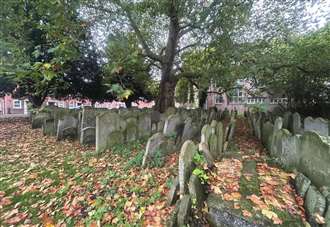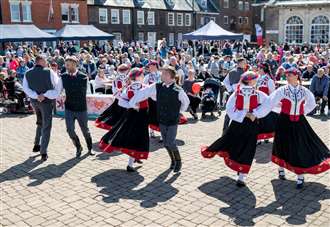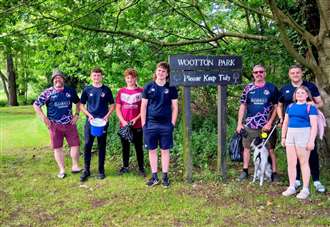-
 play_arrow
play_arrow
Kl 1 Radio Local radio for west Norfolk
-
 play_arrow
play_arrow
KL DISCO KL Disco Playing Disco Music from the 70's onwards.24/7
-
 play_arrow
play_arrow
KL COUNTRY KL COUNTRY Playing New and Classic Country Music 24/7
-
 play_arrow
play_arrow
KL ROX KL ROX The best of New and Classic Rock.24/7
-
 play_arrow
play_arrow
KL SUMMER Summer Vibes 24/7 from KL1 Radio across West Norfolk
-
 play_arrow
play_arrow
KL CLASSICAL Your Symphony Starts Here
-
 play_arrow
play_arrow
KL CHILL Just Chill!
-
 play_arrow
play_arrow
KL POP The Best POP Hits all day Long!
-
 play_arrow
play_arrow
KL XTRA KL XTRA
music_note
Buried bodies, bomb craters and a tribute to a town legend all form part of park’s history


Lynn News editor Jeremy Ransome has enjoyed a tour around the park he grew up living opposite from and discovered its secrets and history…Laying for more than 200 years under the green grass of The Walks are the bodies of hundreds of former Lynn residents who were buried there in the 1800s when the town’s three churchyards became full.Their gravestones moved into a corner when the St James’ Park area of one of England’s largest town parks was developed in the early 1900s, their fate is one of many fascinating tales I discovered during my enjoyable hour with one of Lynn’s Town Guides Gary Walker.
An ancient priory sacked by Henry VIII, one of the town’s largest and oldest trees, former open-air swimming pools, an everlasting tribute to one of Lynn’s great sons and a tiny chapel used for only 50 of its 500-plus years are all stitches in the amazing tapestry of this much-loved Grade II-listed park.I know my guide Gary from his enthusiastic involvement in the weekly Lynn parkrun event held at The Walks every Saturday morning and his love of the town and its park was evident throughout our tour.We met at Tower Gardens, near the town library, where he explained the gardens join nearby St James’ Park and the main park in making up The Walks, which evolved over time from 1686 to 1930.
TOWER GARDENS I learnt something new immediately as Gary explained the gardens stand on the site of an ancient priory, the majestic Greyfriars Tower being the only remnant of that thriving community.From 1235 until their suppression by Henry VIII in 1538 during his Dissolution of the Monasteries, the area housed a priory of Franciscan monks, popularly known as the Grey Friars due to the colour of their robes. By 1577 the monastery had been broken up, looted and destroyed as people helped themselves to building materials, using many of them for their own homes.
Only the tower survived, the thinking being that the 93 foot monument would have had an oil lantern fixed on top and used as a marker for craft coming down the River Ouse from The Wash.Other parts of the monastery remained for several hundred years but were finally dismantled when The Walks was properly established in 1911 to commemorate the crowning of King George V.You might be mistaken for thinking the wall that you see at the edge of the gardens was also part of the original Franciscan priory… but it was taken from a demolished warehouse in Common Staithe Quay at around the time the park was established.
The impressive war memorial was erected in 1921 after the First World War, designed by Oswald Milne and costing £2,250. It contains the names of the 569 individuals from this area who were killed in the Great War, along with a few names of Lynn civilians who perished in bomb attacks, Lynn being one of the first towns to be bombed during the conflict. A separate plaque commemorates those who perished in the Second World War, with their names kept in the nearby library. There is also a Burma Star Memorial commemorating those who were killed in the Far East.As we walked towards St James’ Park, Gary explained that there had once been an oil mill nearby that used to grind up flax. It stood by one of the town fleets, which were water channels running through the town which served as drains, hence the area we now know as Millfleet.The Millfleet and The Purfleet were the main fleets bordering medieval Lynn and were stinking messes full of diseases such as typhoid and cholera as everyone dumped their rubbish and waste in them.The main medieval town started around 1101 really with the establishment of the church of St Margaret’s built between the two fleets. About 50 years later Bishop William III went across the Purfleet and formed a community he called Newlands, establishing what we now know as the Tuesday Market Place and building St Nicholas’ Chapel – the biggest chapel in England. Gary also mentioned the nearby (soon to be replaced) library established by Andrew Carnegie in 1905 … and not too far from that many residents will also remember an aviary containing budgies and other exotic birds.
We then crossed London Road, which was first properly paved under a 1802 Act of Parliament, and wandered into St James’ Park. The type of cobbles used on London Road in 1802 can still be seen in lanes near the quay.Near County Court Road as you walk towards St James’ Park you come across the remains of the 13th Century St James’ Chapel, which was later used as a workhouse before the building collapsed in the mid-1800s. Only a piece of the back wall remains.ST JAMES’ PARK
If I was surprised about the priory, then what originally occupied this park where as a toddler I often visited with my family would really shock me… St Margaret’s Cemetery was established in the early 1800s when the town’s other church yards became full.It was used for only 50 years, however, because the Burial Act came into force, making councils responsible for municipal graveyards. The one currently on Hardwick Road was then established and burials stopped at St Margaret’s. During its use, night watchmen had to be employed to guard against grave robbers, who would steal bodies – especially of children – to sell for examination, experimentation and teaching.
The graveyard was then abandoned for 50 years and became overgrown until plans for the park began in 1901 and the stones were removed and placed together in a corner where they stand to this day. Many stones are only half-filled with inscriptions, the other half still awaiting the details of a loved husband or child who had survived their loved one.Among those buried is the philosopher and rumoured devil worshipper Ezekiel Walker. The graves are in the process of being cleaned up and eventually, an information board will also be erected.The fountain in the centre of the park, which is now dry but full of colourful flowers, was paid for by the mayor at the time in 1903 and there’s a reason most of the flower beds around it are raised… if gardeners dig too deep they will come across bones and bodies. Some of those bones would be much older than the cemetery though as there are records of 395 bodies being piled there after a plague in the late 1500s.As we exited St James’ Park, Gary pointed out the oldest tree in The Walks, set in the middle of the stones. The plane tree has a huge seven-metre circumference and its age has been estimated at 280 years. BROAD WALK
The entrance to the park opposite the library was originally a 17th-century pathway leading from the old town, surrounded by fields, pastures and paddocks. People would visit to get away from the stench of the town. Then in 1753, the foundations of the park were laid when a wealthy merchant called Charles Turner created a promenade, leading to the Guannock Gate part of the town wall, where he could bring his family.He planted hedgerows on either side and alternate lime and horse chestnut trees. He employed people to watch the gates and make sure only the wealthy could enjoy the fresher air.The Bandstand was added in the early 1900s to the area called Vancouver Gardens, named after the famous explorer from Lynn, Captain George Vancouver. The gardens form a complete island to commemorate Captain James Cook’s protégé and the island named after him in Canada.
In the 1930s an outdoor swimming pool and nearby paddling pool were built – they were used regularly by schools and Lynn residents until being closed when the current St James’ Pool was opened in the 1970s.The town wall – dating back to around the 1200s – gave the town great defence and surrounded Lynn, but the area from the edge of the park, through the current railway lines and up to the Kettlewell area formed the only actual stone part. Walking towards the Red Mount, you can see a large crater in the grass in front where a German bomb landed during the Second World War.When we reached the Guannock Gate, Gary explained it was a genuine gate guarded by night watchmen, especially at times of plague, and was also part of the town’s defences during the Civil War. It fell into disrepair but was rebuilt in 1816.The park was extended when Goodwins Road (now Tennyson Road) was built towards the end of the 1800s, with cricket and football played on the new extension, now the vast grassy expanse enjoyed by so many, including me as a child.THE RED MOUNT
The Chapel of St Mary on the Mount was built in 1485 and in 1505 another section was built with a new chapel at the top. It was originally a lay point for pilgrims travelling to Walsingham which had become the most popular pilgrimage site after Canterbury. Pilgrims would pay cash dues which would go to St Margaret’s Church and the chapel made more funds than the church itself.Leaving the original ground-floor chapel, we ascended winding stairs to the first floor, containing the area where the priest stored his sacraments and valuable religious documents and also used as his small living room.
Although small, it’s bigger inside than you think, and the stairs go up to the second floor and the newer chapel. The modern pilgrims who walk from Leicester and Nottingham enjoy tea, coffee and snacks below before singing together in this top room.The original pilgrimages were banned by Henry VIII in 1537, meaning that for its 539-year history, the Red Mount has only been used for about 50 years as an actual chapel.During the English Civil War from 1642-51, the original chapel at the bottom was used as a gunpowder store and it has also been a water store and an observation point for amateur astronomers. It eventually fell into disrepair and people stole bricks and tiles. Some restoration work was carried out in the 1800s and then in 2008, extensive restoration took place with National Lottery money.The walls of the top floor are covered in ancient graffiti going back to the 1600s, including one mark from a Freemason and one from ‘Inky’ in 1858. Much of the writing is more elaborate than you may have expected from people at the time.My favourite carving was one from 1721 that shows the King’s Colour, the first Union Flag, which was used from 1707 to 1801 and was the precursor to the Union Jack of 1801.There is also a legend that there is a tunnel from the chapel to Castle Rising Castle. Bats also hibernate here during the winter so tours are postponed from the end of September to April.Leaving the historic chapel, we then walked along a further extension of the park down what is called St John’s Walk, heading to the church of the same name.ST JOHN’S CHURCH
Built on the side of the graveyard, Gary said this church also holds a fascinating story.Before Sandringham House became a Royal Estate it was owned by a man named John Motteux, who was annoyed that when he came into town to pray at St Nicholas’ Chapel, he kept getting moved back from where he wanted to sit as people had paid for their pews.Motteux thought that was wrong – not just for him but for the poorer members of the public – and decided to raise the funds to build a free church for everyone. In 1856 St John’s was built after he donated the first £2,000 of the £5,000 costs and covered the rest with subscriptions from local farmers and merchants.The evangelical church was Lynn’s first free church, much to the annoyance of some of the Anglicans of the time.Our chat about the church concluded a fascinating tour and I was so pleased to have found out so much about an expanse that for decades had been merely somewhere I’d enjoyed kicking a football and wielding a cricket bat.The Town Guides tour season has recently finished for 2024 and will start again in April with many different tours around the town but you can ask for a private walk by visiting the website at www.kingslynntownguides.co.uk and requesting one.Got a story? Email newsdesk@lynnnews.co.uk
Similar posts
Upcoming shows

Paul Baker – KL1 Breakfast
7:00 am - 10:00 am

Chris Fisher – KL1 Mornings
10:00 am - 1:00 pm

Ian Campfield – KL1 Afternoons
1:00 pm - 4:00 pm

Richard Dix – KL1 Drive
4:00 pm - 7:00 pm

80’s ’til 8
7:00 pm - 8:00 pm
Message Us
Copyright The Mediasite UK - 2025








